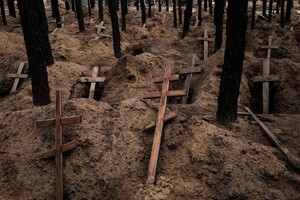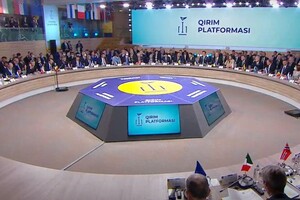Putin Makes Up His Mind: How the War with Russia Will Look This Year
A lasting war? A truce? Withdrawal of troops?
These plans of Russia’s next actions in Ukraine are on the president’s desk in the Kremlin.
However, judging by the militaristic rhetoric of the Russian president’s New Year address and during his visit to the Obukhov plant in St. Petersburg, Putin has already made up his mind – there will be a long “people’s” war of Ukraine’s attrition. After all, the strategic goals for the Kremlin “recluse” remain unchanged, namely establishing control over Ukraine, destroying Euro-Atlantic unity, and seizing the initiative in the geopolitical game. In a word, the task is to break the entire world order that has been formed after the Cold War.
For Putin, the stake in the war is not only the future of the Russian state, its integrity, imperial greatness and international prestige, but also his own life and personal place in history.
Therefore, it is important for him not just to keep the occupied territories or “liberate” the entire Donbas, but also to capture Kyiv as “one of the centers of Russian statehood.” That is why the threat of a repeated attack from Belarus on the Ukrainian capital remains high. In spite of everything, Putin does not care whether Belarusian soldiers will take a direct part in the operation – the Kremlin ruler is counting on Russia’s unlimited resources, planning to break the way to the “second Jerusalem” with the bodies of mobilized thugs. The capture of Soledar is a vivid demonstration that the Kremlin will not stop at any price.
To achieve its goal, Moscow is preparing for a counteroffensive at the front and launching missile strikes on houses of Ukrainians and critical infrastructure. At the expense of their destruction, the Russian military and political leadership is trying not only to break the will of Ukrainians, but also to convince the main donors of our country (primarily such countries of the European Union as France and Germany) that it is pointless to invest resources in Ukraine. Betting on Russia’s resource dominance over Ukraine, Putin believes that the West will gradually reduce aid to our country, as the price of this support will increase for it.
In this long-distance race, Putin is reorganizing the military command of Russian forces on the Russian-Ukrainian front and gradually putting Russia on a war footing: rebuilding the economy, mobilizing, militarizing Russian society, and preparing to close the borders and introduce martial law in the country. All these measures should strengthen the capabilities of the Russian army and contribute to its victory.
As part of the strategy of a long war, Putin also benefits from a scenario in which Kyiv and Moscow conclude a truce.
Firstly, it will give the Russian army time to prepare for revanche. Secondly, it will allow the economy to be rebuilt for military requirements (British military analysts believe that a significant mobilization of the Russian economy should be expected by autumn). Thirdly, it will demonstrate to the Russian society the victory on the “special military operation” front, recording a new “territorial reality.” Fourthly, it will show urbi et orbi Russia’s “good will” to resolve the “conflict” peacefully.
But will Russian society be able to live for the needs of the front, as in WWII, and the Russian economy to switch to war footing?
Kremlin propagandists are zombifying Russians, cultivating the “sanctity” of the “special military operation” in society and calling on compatriots not to be afraid to die, while the voice of opponents of the war is practically not heard in the country. Many have left. And those few Russians who risk not even manifesting in public the slogan “No War” but writing “*** *****” (eight asterisk symbols standing for “No War” phrase in Russian with three symbols for the Russian word “no,” five asterisks for “war”), are dismissed from their jobs, fined, and imprisoned. Caught on the hook of resentment and imperial nostalgia, 63 per cent of Russian citizens regret the collapse of the Soviet Union.
According to The Wall Street Journal, the polling, conducted by the Public Opinion Fund shows that despite the initial dissatisfaction with the mobilization announced in September 2022, the Russians are ready to “endure another wave.”And if in September the number of Russian citizens who support the continuation of hostilities in Ukraine significantly dropped to 34 per cent, then in early November the level of support increased and reached 80 per cent.
Currently, the Kremlin is preparing for a new wave of mobilization, seeking to ensure a constant flow of human resources to the front. According to the Defence Intelligence of the Ministry of Defense of Ukraine, in January 2023, the Russian authorities plan to mobilize another 500,000 Russians in addition to the 300,000 drafted into the army last fall. In Russia, they also intend to establish a new conscription age – from 21 to 30 years instead of from 18 to 27 years. Moreover, for the “transitional period” it is planned to leave the lower bar at 18 years and raise the upper one to 30 years.
To provide ammunition to the mobilized, Russian emissaries send relevant orders to neutral or “friendly” countries to Russia. So, companies in Belarus, Iran, Vietnam, and China received orders for tailoring uniforms. (Meanwhile, Russians discuss the low quality of tailor-made uniforms.) Canneries in Belarus are also largely oriented to the needs of the Russian army.
Faced with a shortage of large-caliber projectiles and rockets for jet artillery last summer, the Russians, according to ZN.UA, emptied warehouses in Belarus by 70 per cent. Representatives of Russia also began to buy ammunition in the countries of the Middle East, Africa, and Asia, where Moscow previously supplied these missiles and shells along with military equipment. In addition, the DPRK has sent weapons to the Wagner Group members, and the Russian army is waiting for the delivery of ballistic missiles from Iran.
In Kyiv, it is believed that the problems with the provision of mobilized thugs had a negative impact on their combat training. According to the Russians, the Kremlin’s delay in announcing the partial mobilization has led to escaping of personnel from various military training centers and schools. The infrastructure of training grounds in Russia was also unprepared for the accommodation and training of about 150,000–200,000 mobilized thugs (about 100,000–150,000 men were immediately sent to combat units in Ukraine without the necessary training). One of the options for getting out of such a situation was the placement of about 12 thousand Russian soldiers in Belarus.
The United States also considers it unlikely that Russia will be able to train and arm 500,000 soldiers simultaneously. “Indeed, the mobilization of as many as 500,000 is an incredible thing. You, of course, wonder whether it will be possible to train and provide for such a large number of people under such conditions. I suspect that if Putin mobilizes such a large number of troops, neither will happen,” US Deputy Secretary of State Wendy Sherman stated during a recent visit to Kyiv.
However, even a poorly prepared horde of several thousand is a serious danger for us – and it should not be underestimated.
Putting the economy on a war footing in the face of international sanctions, the reduction of the European sales market for Russian energy carriers and the fall in Urals oil prices, the steady degradation of economic life, the Kremlin is putting pressure on large state-owned companies to get more money for the war. After the authorities ordered Gazprom to pay 1.2 trillion rubles. of additional taxes, according to the decision of Mishustin’s government, producers of coal and fertilizers should also “chip in” for the war: they may be required to pay “dividends” in the amount of more than 50 per cent of the net profit.
Despite the large-scale measures to transfer the Russian economy to the war footing (a 24-hour working regime has been implemented at the military industry enterprises, technical training college students are forced to work in factories, the labor of prisoners is used in the military industry, etc.), it will be difficult for the Kremlin to do this. The Russian Federation is not the USSR, and privatized factories cannot immediately switch to the production of armored personnel carriers and missiles, and there are not enough state-owned enterprises. In addition, there are difficulties with the production of high-tech weapons due to restrictions on the supply of microchips to Russia.
The growing economic problems in the country, in particular due to the sanctions introduced by the international community, will plunge the Russian economy into recession. However, the Russian authorities expect that, against the backdrop of significant capital outflows and declining incomes of the population, payments to soldiers for injuries or payments to families in the event of their death will effectively solve the problem of replenishment of working capital. In addition, this money will level the growth of discontent in society due to long-term losses during the hostilities in Ukraine. Generally, in Moscow, some believe and some hope that all these problems will not prevent the successful completion of the military campaign against the “Nazi regime” in Ukraine.
Read this article in russian and Ukrainian.
Please select it with the mouse and press Ctrl+Enter or Submit a bug















 Login with Google
Login with Google